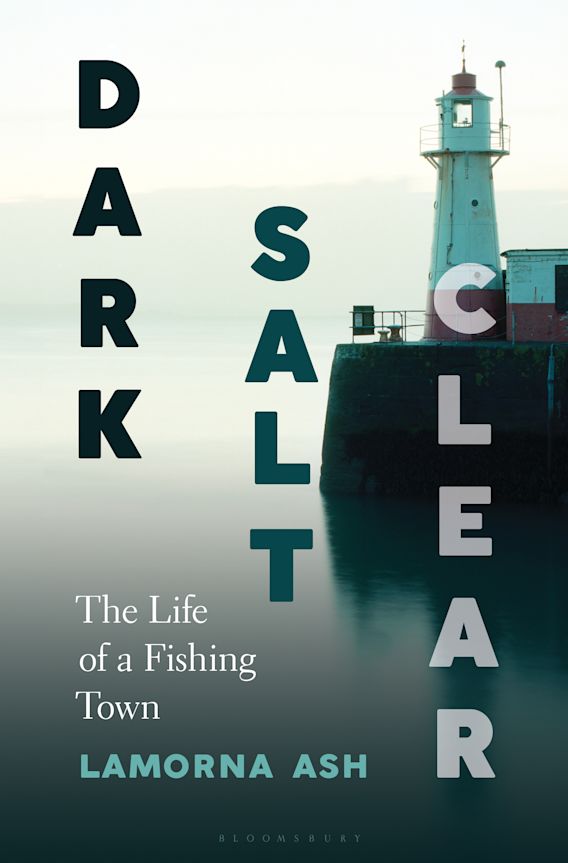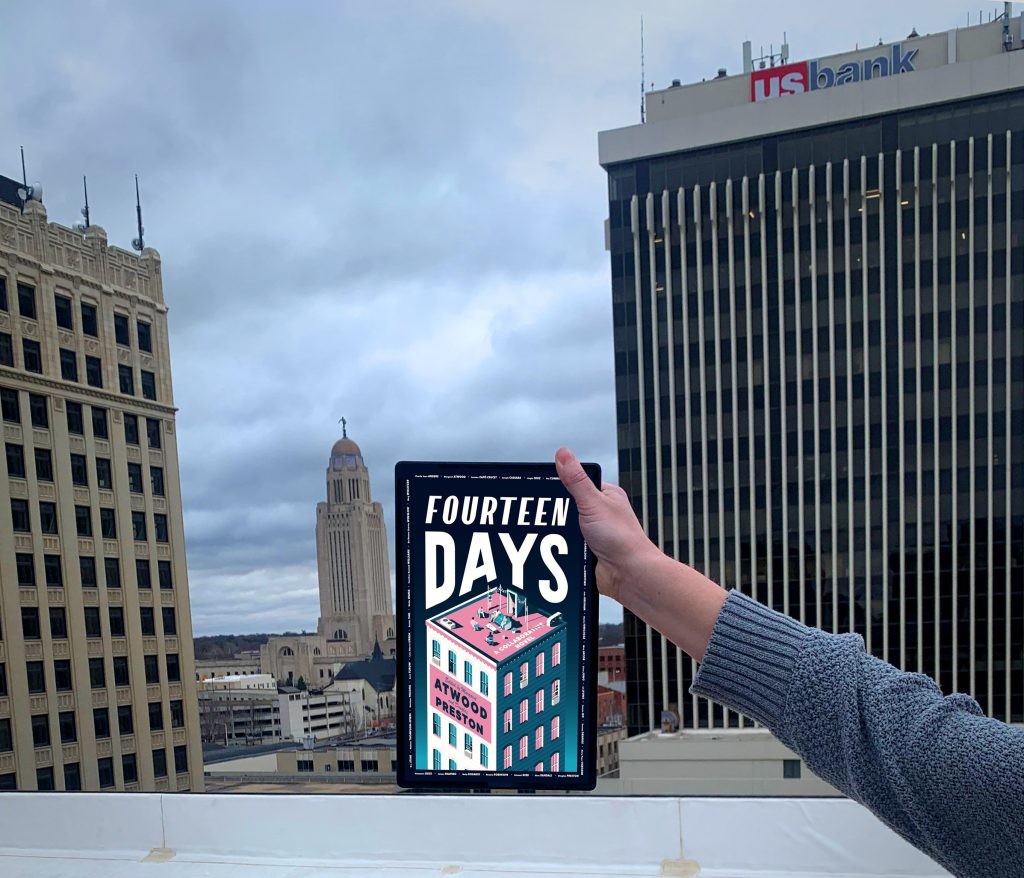Search the Blog
Categories
- Books & Reading
- Broadband Buzz
- Census
- Education & Training
- General
- Grants
- Information Resources
- Library Management
- Nebraska Center for the Book
- Nebraska Memories
- Now hiring @ your library
- Preservation
- Pretty Sweet Tech
- Programming
- Public Library Boards of Trustees
- Public Relations
- Talking Book & Braille Service (TBBS)
- Technology
- Uncategorized
- What's Up Doc / Govdocs
- Youth Services
Archives
Subscribe
Tag Archives: Reading
Book Club Spotlight – The Rim of the Prairie
Today, as we prepare for another Nebraska summer, we will be reading a classic of Nebraska literature, Rim of the Prairie by Bess Streeter Aldrich. Born in Iowa, Aldrich moved to Elmwood, Nebraska, with her husband and child in her late 20s. Aldrich’s writing became a full-time job when her husband passed away in 1925, shortly after sending in the manuscript for what would become her first full-length novel, The Rim of the Prairie. Though not a native Nebraskan, Aldrich fully embraced the state as her own. She was awarded an Honorary Doctorate from the University of Nebraska and inducted posthumously into the Nebraska Hall of Fame in 1973. Her book A Lantern in Her Hand was the 2009 One Book One Nebraska.
Small and midwestern is Maple City when young banker Warner Field retreats to a lonely cabin on the Moore property for a vacation focused on his once great love for writing. While there, he happens upon artifacts of a young girl who once used the cabin. Small journal entries, a china doll, and an old photograph lead him to believe the owner of these items is long passed on. He finds fascination in her lush descriptions of the prairie all around him, her poetic styling and love for her surroundings touch him deeply. Through the journals, he learns of an mysterious tragedy, the girl’s entries abruptly stopping on her 18th birthday as she prepares to run away. Only a day before he departs from the cabin, 22-year-old Nancy Moore steps off the train and arrives home in Maple City for the first time in 4 years after her disappearance.
“There was something about the lunch that was gayer than usual. An atmosphere of fun pervaded it, a sense of exhilaration was upon every one. Nancy Moore seemed in some inexplicable way to be responsible for it. There was something infectious about her approval of life”
Bess Streeter Aldrich
This unassuming Nebraskan mystery romance contains a portrait of rural life during the turn of the century. Maple City and its inhabitants coexist in their own peculiar but charming and folksy ways with their own secrets kept close to their chests. In The Rim of the Prairie, Aldrich weaves her thoughts on life, her love for her husband, and the day-to-day foils and perseverance of prairie life. Appropriate for Book Groups of all ages, readers can enjoy the lush descriptions of the prairie in contrast with the bustling small town trying to stretch its wings into the modern day, and the mystery of the brown shawl. Encouraged to read by my mother, (Happy late Mother’s Day!) The Rim of the Prairie was one of the first books I read that took place in Nebraska. It gave me the words to shape my cultural identity and knowledge of our greater social landscape. As Aldrich said herself, “I tried to do my bit in helping preserve a little of the spirit of these pioneers in fiction”.
If you’re interested in requesting The Rim of the Prairie for your book club, you can find the Request Form here. There are 10 copies available. (A librarian must request items)
Aldrich, Bess Streeter. The Rim of the Prairie. University of Nebraska Press. 1966
Posted in Books & Reading
Tagged book club spotlight, books, Nebraska Authors, Reading
Leave a comment
Friday Reads & BookFace Friday: “Making It So” by Patrick Stewart
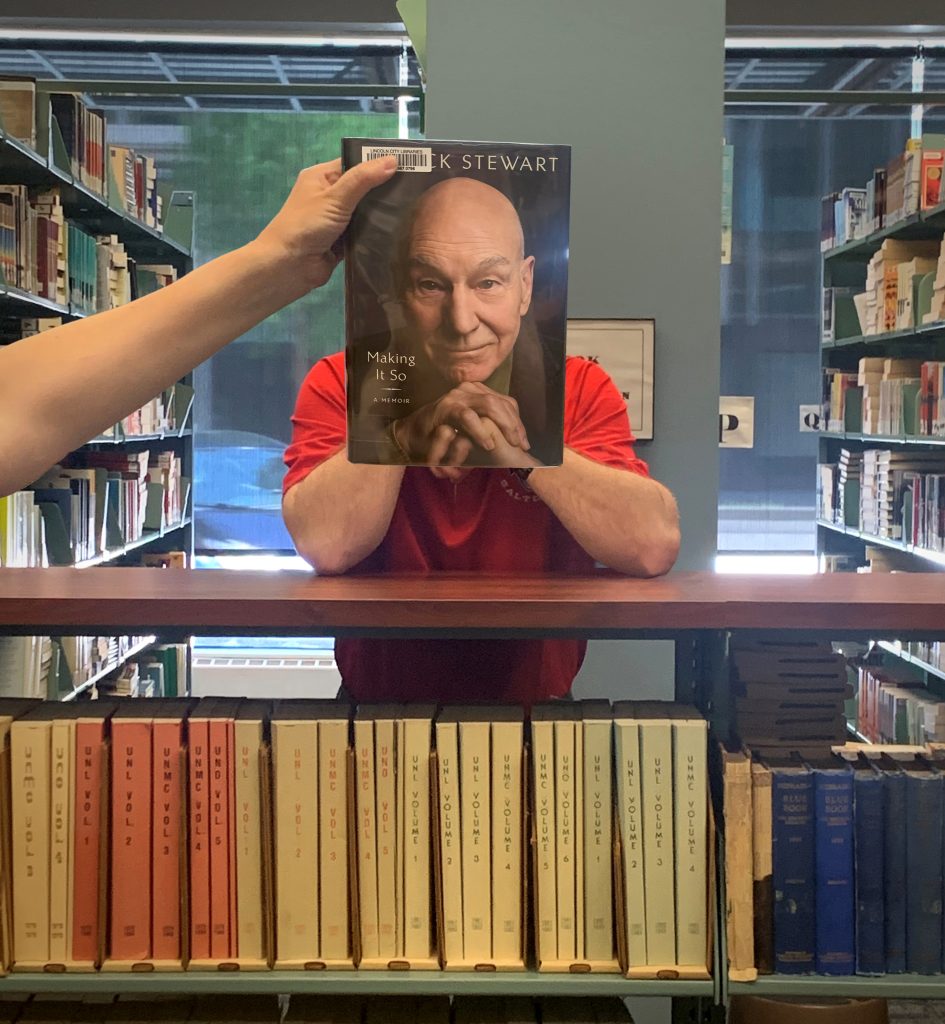
I remember watching and enjoying Star Trek: The Next Generation, starring Patrick Stewart as Jean-Luc Picard, but I wouldn’t call myself a diehard Trekkie. That was no barrier to finding Making It So, Stewart’s recently released memoir, enchanting and delightful. Especially the Audie award-winning audio edition, narrated by Stewart, himself.
As you can imagine, he declaims every word of every sentence with gusto!Stewart (b. 1940) starts at the beginning, describing what it was like growing up working class in Yorkshire in the 1940s and early 1950s. This includes a brief etymology lesson on the Yorkshire dialect he grew up speaking, which, according to Stewart, would have been “nearly incomprehensible to Londoners, let alone Americans.” For instance, he explains that “ata,” which meant “are you,” descended from “art though”; “nowt” meant “nothing”; “Geroff!” meant “leave me alone”; and a chamber pot was a “gazunder,” because it “goes under” the bed. This is relevant since in order to become an actor he had to learn “received pronunciation,” or “RP.” (RP was the standard pronunciation used by BBC broadcasters back in the day.)
Stewart also does a good job conveying the degree to which theater permeated English society at the time. It ranged from amateur dramatics (“am-drams”) at the local level, to a network of regional repertory theaters, all the way up to the Royal Shakespeare Company in Stratford-upon-Avon and the National Theatre in London. And thanks to financial support by the government in the form of grants and scholarships, it was accessible to all—even a working-class boy like Stewart, who got his start locally and then worked his way to the top.
If you are particularly interested in the Star Trek: Next Generation portion of this memoir, you’ll have to be patient, or skip to chapter 16. From there on out (there are a total of 25 chapters in the book), you will be rewarded with lots of insider, behind-the-scenes information about Stewart’s time as Picard. There are also plenty of details about his stint as Charles Xavier in the X-Men movie franchise, and voice work for Seth MacFarlane’s Family Guy and American Dad, as well as other television, film, theater, and social media projects he’s participated in, including reciting all Shakespeare’s sonnets on Instagram during the pandemic lockdown.
While this memoir will appeal to Trekkies, theater nerds, and Anglofiles, there are also elements that will resonate with anyone who has lived a long life filled with both gratitude and regret. In later chapters, Stewart expresses remorse over the demise of his 23-year marriage to his first wife, and the damage that did to his relationship with their children, Daniel and Sophie: “[T]he hurt caused by my split with their mother has never fully gone away,” he writes. After a second brief marriage falls apart, he laments: “And so, another divorce. I felt stupid and responsible.” But he also joyfully expounds on life with his third wife, Sunny Ozell, to whom he’s been married since 2013, as well as his well-publicized friendship with Ian McKellen. Overall, Stewart comes across as a vibrant, engaged octogenarian who, despite living a full, rich life, is still ready for more!
Stewart, Patrick. Making It So: A Memoir. Gallery Books, 2023.
You can find “Making It So: A Memoir” by Patrick Stewart as an eBook in Nebraska OverDrive Libraries! Libraries participating in the Nebraska OverDrive Libraries Group currently have access to a shared and growing collection of digital downloadable audiobooks and eBooks. 194 libraries across the state share the Nebraska OverDrive collection of 26,174 audiobooks, 36,611 ebooks, and 5,210 magazines. As an added bonus it includes 130 podcasts that are always available with simultaneous use (SU), as well as SU ebooks and audiobook titles that publishers have made available for a limited time. If you’re a part of it, let your users know about this great title, and if you’re not a member yet, find more information about participating in Nebraska Overdrive Libraries!
Love this #BookFace & Friday Reads? We suggest checking out all the titles available in our Book Club collection, permanent collection, and Nebraska OverDrive Libraries. Check out our past #BookFaceFriday photos on the Nebraska Library Commission’s Facebook page!
Posted in Books & Reading, General
Tagged Book Covers, bookface, bookfacefriday, Ebook, Friday Reads, Making It So, Memoir, Nebraska OverDrive Libraries, Patrick Stewart, Reading
Leave a comment
#BookFaceFriday “Two Tribes” by Emily Bowen Cohen
This #BookFaceFriday is the best of both worlds!
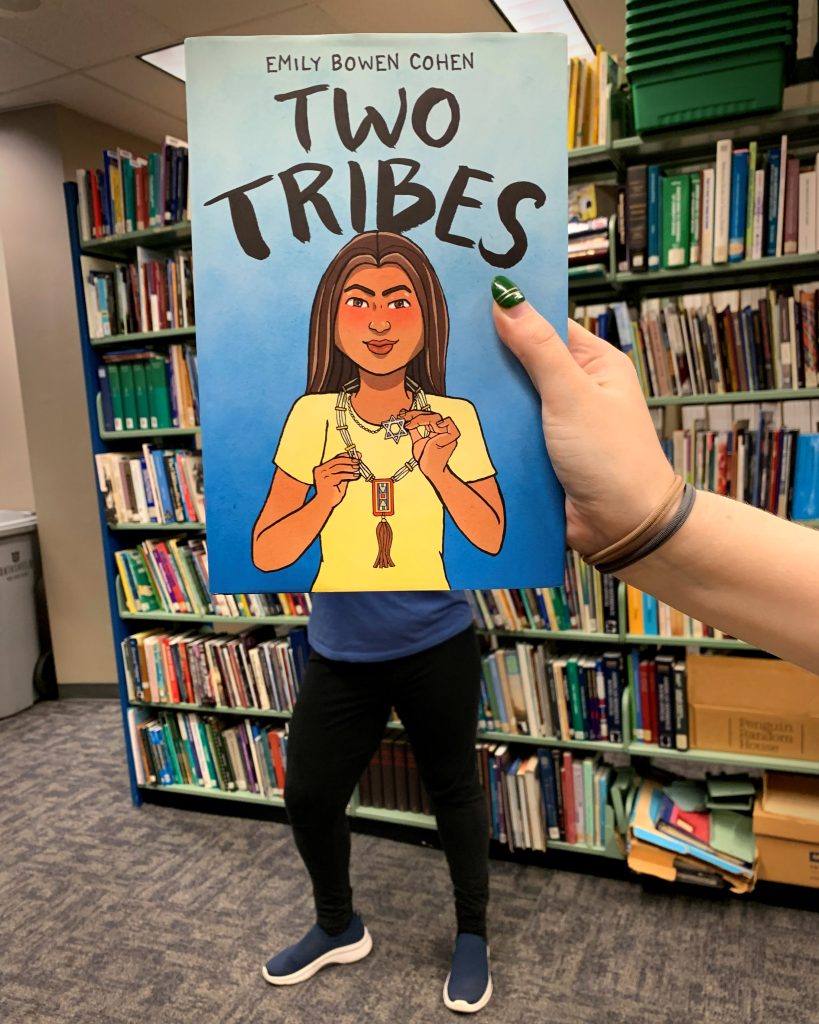
It’s a picture perfect #BookFace, with “Two Tribes” by Emily Bowen Cohen (Heartdrum, 2023) it is a graphic novel geared towards YA or tween readers based on the author’s real life. You can hear all about it on our Children and Young Adult Library Services Coordinator, Sally Snyder’s, “Best New Teen Reads of 2023” NCompass Live presentation. You can watch the recording and find out all about her book lists on the NCompass Live webpage. In this episode, Sally and Dana Fontaine, Fremont High School Librarian, give brief book talks and reviews of new titles recommended to school and public librarians, covering both middle and high school levels, that were published within the last year.
“In Mia’s struggle to reconcile her ancestries, the creator develops a credible portrayal of self-image and acceptance. Plentiful panels rendered in earth tones further enhance this nuanced portrait of Mia’s search for identity.”
—Publishers Weekly
Love this #BookFace & reading? Check out our past #BookFaceFriday photos on the Nebraska Library Commission’s Facebook page!
Friday Reads: Atlantis, by David Gibbins
I am a huge fan of adventure novels and movies, so over the years I have really enjoyed the various books of Clive Cussler, Steve Berry, Dan Brown, David Baldacci, and Lee Child. An action/adventure author that I hadn’t read, David Gibbins, popped up on my radar recently, so I decided to try his first novel in the Jack Howard series, Atlantis, and it did not disappoint! Atlantis was written in 2005, and there are now 11 books in the series , so I’m really looking forward to reading the next one!
Archaeologist Jack Howard is a brave but cautious man. When he embarked on a new search for buried treasure in the Mediterranean, he knew it was a long shot. When he uncovered a golden disc that spoke of a lost civilization more advanced than any in the ancient world, he started to get excited. But when Jack Howard and his intrepid crew finally got close to uncovering the secrets the sea had held for thousands of years, nothing could have prepared them for what they would find in the murky depths – not only a shocking truth about a lost world but an explosive secret that could have devastating consequences today. Jack is determined to stop the legacy of Atlantis from falling into the wrong hands, whatever the cost. But first he must do battle to prevent a global catastrophe! **Synopsis courtesy of Fantastic Fiction**
Book Club Spotlight – Pachinko
Pachinko by Asian-American Author Min Jin Lee is an epic historical novel that was a labor of love that spanned decades of work and research. Focusing on the imperial rule of Japan, Pachinko follows the diaspora of Koreans in Japan who faced racism and discrimination in both work and society. A National Book Award Finalist, the novel and Lee were awarded the Manhae Grand Prize for Literature, one of Korea’s highest honors in literature. The branching story of Pachinko revolves around the character of Sunja, who, as events transpire, is the perpetual foreigner in life. Not only is she literally a foreigner in Japan, but as a woman, impoverished widower, and carrying the shame of her firstborn’s father, she will always be on the outside of a society puppeteered by men above her station.
On a small inlet outside Busan, Korea, Sunja is the young, mild-mannered, but steadfast daughter of a small lodging house owner. Living a fairly isolated life outside of the bustling town, Sunja encounters a much older man who gains her confidence and impregnates her. Believing he intends to marry her, Sunja is devastated to learn he is already married as her world crashes in on her. Before her due date, a sickly Protestant Minister offers to marry her out of the kindness of his heart to help support her and the soon-to-be-born child, Noa. Together the couple moved to Japan and had another son, Mozasu. As foreigners in Japan, the family experiences the daily hardship of poverty, World War II, and second-class citizenship as Koreans. Spanning 1910 to 1989, Pachinko follows the family as it grows and branches off in this sweeping epic of what it takes to love despite odds that will always be against them.
“Living every day in the presence of those who refuse to acknowledge your humanity takes great courage”
– Min Jin Lee
Even though about 1 in every 7 Japanese adults play the game pachinko, the work is associated with ethnic Koreans. After the war’s devastation, Koreans in Japan had a hard time getting job opportunities, and the shady business welcomed them with open arms. And like many, Mozasu and Noa’s best option was through Pachinko, their lives, like the ball bearings on an uncontrollable path of fate. Lee’s Pachinko encourages and helps the reader discover a portion of history that adult Book Club groups can approach with an eye for themes of marginalization and forever ostracization as world events are woven around these minor players. Lee, who aimed to write “compelling stories of individuals who struggled to face historical catastrophes,” asks what choices are there when you are functionally powerless.
To see more of our Asian American & Pacific Islander Voices book club titles for AAPI month, visit here
If you’re interested in requesting Pachinko for your book club, you can find the Request Form here. There are 6 copies available. (A librarian must request items)
Lee, Min Jin. Pachinko. Grand Central Publishing. 2017.
#BookFaceFriday “Between the Lines” by Nikki Grimes
Extra! Extra! Read all about this #BookFaceFriday!
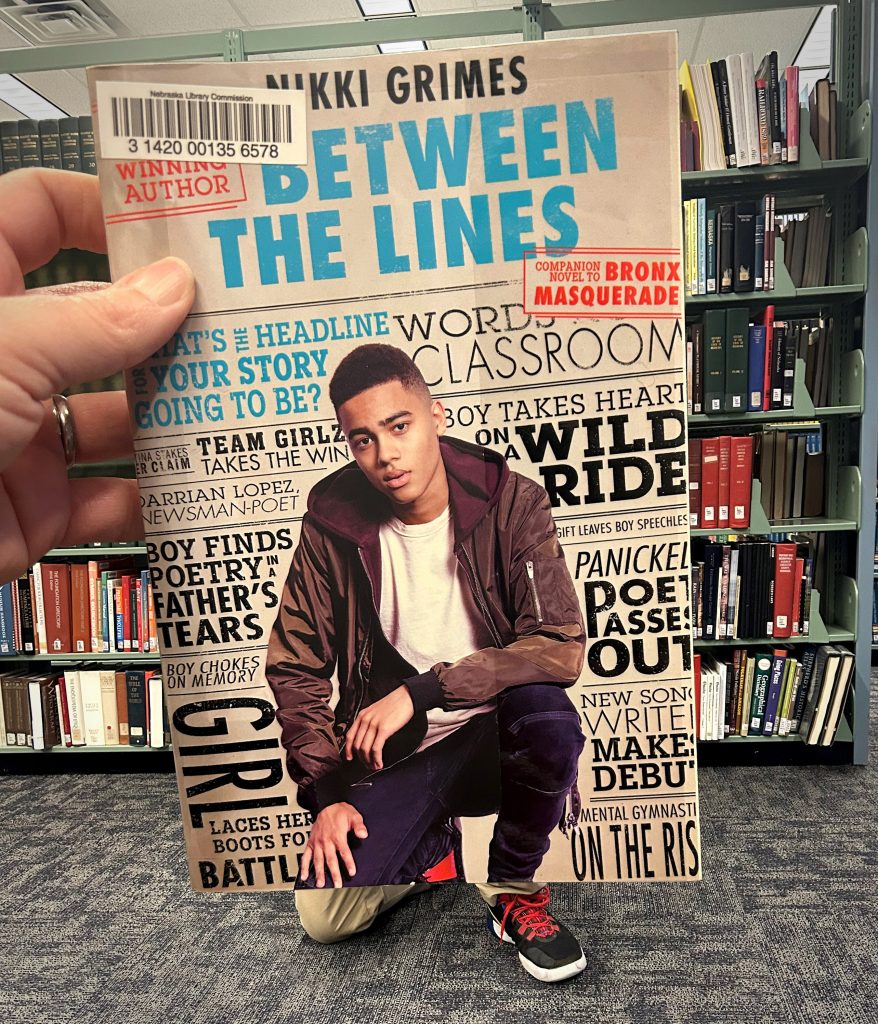
This week’s #BookFace is the 2024 selection for One Book for Nebraska Teens “Between the Lines” by Nikki Grimes (Nancy Paulsen Books, 2019).
In case you missed it, this week’s NCompass Live was all about our One Book for Nebraska Kids and Teens program, you can still watch the recording and find out all about the program on the NCompass Live webpage. This book is available as a part of our Book Club Kit collection; we have ten copies along with a discussion and activity guide. The Nebraska Library Commission has a large collection of children and young adult titles available to school and library book clubs. You can even search the collection based on grade level to find age and reading level appropriate books.“These complex students use poetry to find their truest voices and write their own stories. . . . Each character occupies his or her own space and no one character or voice monopolizes the story. The narratives of immigrants, foster children, families effected by incarceration, and teens taxed with familial burdens are thoroughly explored in a thought-provoking way. The poems and voices are a perfect blend of the many facets of American teens’ lives. An excellent companion book that lends itself easily to a teacher’s poetry unit, this is great choice for school and public libraries.”
—School Library Journal
Book Club Kits Rules for Use
- These kits can be checked out by the librarians of Nebraska libraries and media centers.
- Circulation times are flexible and will be based upon availability. There is no standard check-out time for book club kits.
- Please search the collection to select items you wish to borrow and use the REQUEST THIS KIT icon to borrow items.
- Contact the Information Desk at the Library Commission if you have any questions: by phone: 800/307-2665, or by email: Information Services Team
Love this #BookFace & reading? Check out our past #BookFaceFriday photos on the Nebraska Library Commission’s Facebook page!
#BookFaceFriday “Nothing but the Truth” by Avi
You can’t handle the #BookFace!
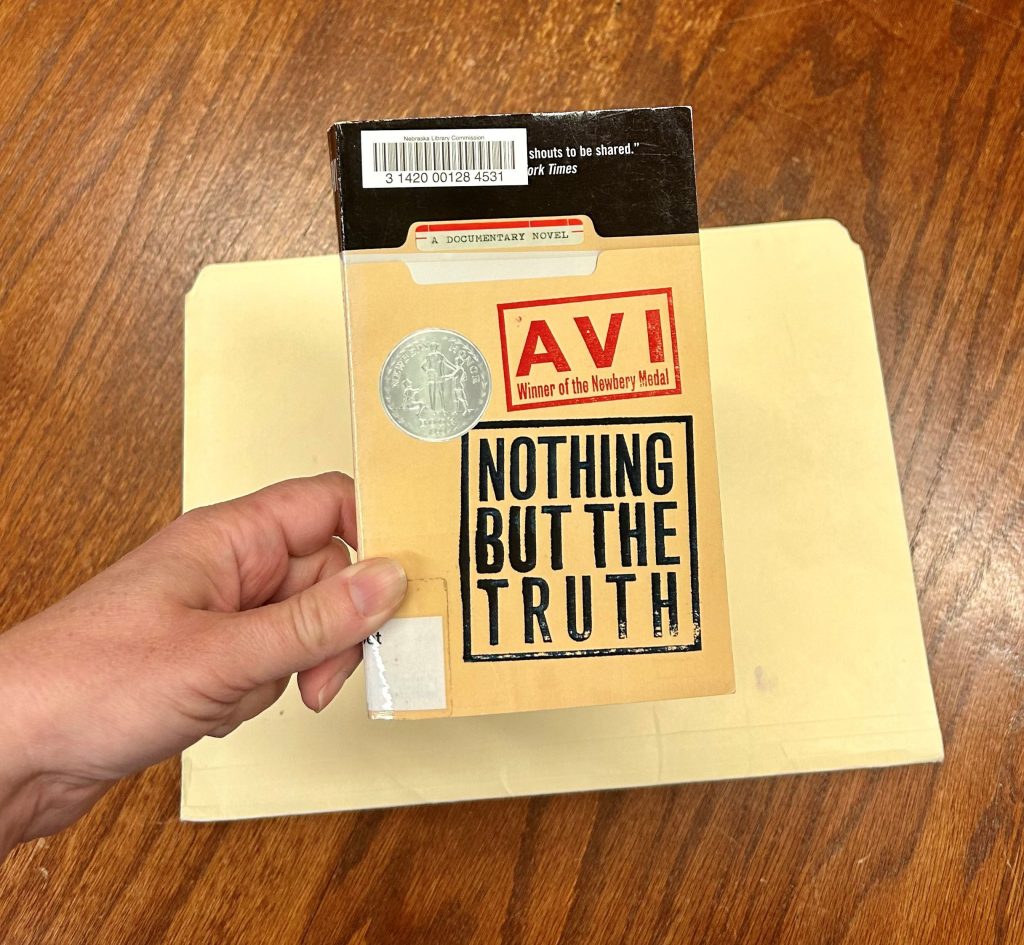
This week’s #BookFace is Newbery Honor Book, “Nothing but the Truth: A Documentary Novel” by Avi (Scholastic, 1991). It’s available as a part of our Book Club Kit collection; we have ten copies along with study questions.
The Nebraska Library Commission has a large collection of children and young adult titles available to school and library book clubs. You can even search the collection based on grade level to find age and reading level appropriate books.“Structured as a series of journal entries, memos, letters and dialogues, this highly original novel emerges as a witty satire of high school politics, revealing how truth can easily become distorted.”
—Publisher’s Weekly (Starred Review)
Book Club Kits Rules for Use
- These kits can be checked out by the librarians of Nebraska libraries and media centers.
- Circulation times are flexible and will be based upon availability. There is no standard check-out time for book club kits.
- Please search the collection to select items you wish to borrow and use the REQUEST THIS KIT icon to borrow items.
- Contact the Information Desk at the Library Commission if you have any questions: by phone: 800/307-2665, or by email: Information Services Team
While we don’t have this particular title available through Nebraska OverDrive Libraries, we do have a significant number of the author’s other works available. You can find twenty books by Avi in the Kids and Teens section. Libraries participating in the Nebraska OverDrive Libraries Group currently have access to a shared and growing collection of digital downloadable audiobooks and eBooks. 194 libraries across the state share the Nebraska OverDrive collection of 26,174 audiobooks, 36,611 ebooks, and 5,210 magazines. As an added bonus it includes 130 podcasts that are always available with simultaneous use (SU), as well as SU ebooks and audiobook titles that publishers have made available for a limited time. If you’re a part of it, let your users know about this great title, and if you’re not a member yet, find more information about participating in Nebraska Overdrive Libraries!
Love this #BookFace & reading? Check out our past #BookFaceFriday photos on the Nebraska Library Commission’s Facebook page!
Posted in Books & Reading, General, Youth Services
Tagged Avi, book club kit, Book Covers, bookfacefriday, libraries, Newbery Honor, Nothing but the Truth, Reading, YA books, Young Adult
Leave a comment
Friday Reads: The Last Man, by Mary Shelley, with a new foreword by Rebecca Solnit
When I read that Rebecca Solnit wrote a new foreword for a Mary Shelley book, and it was one I hadn’t read yet, The Last Man, I jumped to acquire the new Penguin edition. Solnit writes so eloquently on many topics close to my heart, and Shelley’s Frankenstein is one of my favorite books—I reviewed it for this blog some time ago, here.
We knew Mary Shelley invented the Frankenstein genre, of course, and is often credited (correctly, I would say) with writing the first science fiction novel when she did. It turns out that a few years later, she also wrote the first Western novel about human extinction, as well as the first book in the genre now known as “climate fiction.” When Shelley wrote this book, The Last Man, the skies over Europe were dark because of a volcanic eruption, a cholera epidemic was cutting swaths out of the human population, and England’s political parties were battling over the future identity of the country. The author was also dealing with terrible personal loss, including the recent death of her husband, the poet Percy Bysshe Shelley, and their special friend, the poet Lord Byron.
This dystopian novel, set in the late twenty-first century, was not well-received by critics or the general public when it was published in 1824, but modern readers find much to explore and enjoy here. (Perhaps the book was “ahead of its time” in more ways than one.) Shelley invented lore about “finding” secret writings in a cave in Naples that she fashioned into this text, with a story that runs from 2073-2100. The foreword to the 2024 edition, by Rebecca Solnit, expertly connects Shelley’s concerns with ours, two hundred years later.
If you’d like to read or listen to an earlier edition of this novel right this minute, you’re in luck, because it’s 200 years old so it’s definitely in the public domain! The Internet Archive has many options to read the work (here is one option for volume 1 of 3) and Librivox has free audio (here is one option). I appreciate how many wonderful texts and works are available through the Internet Archive—if you haven’t explored there, this is a great time to start.
And if you’re in Nebraska, we have a couple of editions (from 1993 and 2006), from University of Nebraska Press, in our circulating collection to check out. You can search our OPAC here to request a copy.
Shelley, M. W., Solnit, R., & Havard, J. O. (2024). The last man. Penguin Classics.
What’s Up Doc? New State Agency Publications at the Nebraska Library Commission
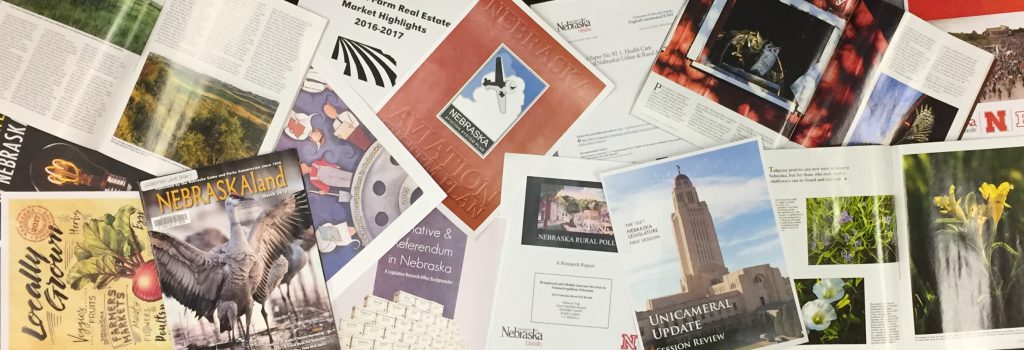
New state agency publications have been received at the Nebraska Library Commission for January and February, 2024. Included are reports from the Nebraska Bureau of Sociological Research, the Nebraska Foster Care Review Office, the Nebraska Department of Transportation, and the Nebraska Workers’ Compensation Court, to name a few.
Items are available for immediate viewing and printing by clicking directly in the .pdf below.
The Nebraska Legislature created the Nebraska Publications Clearinghouse in 1972 as a service of the Nebraska Library Commission. Its purpose is to collect, preserve, and provide access to all public information published by Nebraska state agencies. By law (State Statutes 51-411 to 51-413) all Nebraska state agencies are required to submit their published documents to the Clearinghouse. For more information, visit the Nebraska Publications Clearinghouse page, contact Mary Sauers, Government Information Services Librarian; or contact Bonnie Henzel, State Documents Staff Assistant.
Posted in Books & Reading, Education & Training, General, Information Resources, What's Up Doc / Govdocs
Tagged books, GovDocs, Reading
Leave a comment
Book Club Spotlight- Dracula
Welcome to the 50th Book Club Spotlight! This project is a labor of love and curiosity, and I hope it has provided a solid resource for readers these past 2 years. 🙂
I know what you’re thinking- here at The Book Club Spotlight, we pride ourselves on always being on theme. So why, in spring, are we talking about Dracula? While spooky stories never go out of season, now is the best time to start your reading journey into the world of Dracula. Published in 1897 by Bram Stoker, the epistolary novel is composed of diary entries, letters, newspaper clippings, and transcripts. According to these, the chronological period of Dracula takes place from the beginning of May until early November, meaning one can easily read along day by day and experience the story in real time! So, I invite you to “come freely. Go safely; and leave something of the happiness you bring”.
On the 3rd of May, Jonathan Harker, a solicitor from Exeter, is well on his way to visit a client in Transylvania. This will be the most important deal of his short career, and he is eagerly awaiting the meeting. Little does he know that his client has something more in mind than a simple real estate agreement. As time passes and Jonathan doesn’t return from his trip, his fiancée, the savvy Mina, notices her dear friend Lucy Westenra is beginning to act strange. She experiences bouts of sleepwalking and anemia while large bats stalk the premises. Enlisting the help of Lucy’s own fiancé Arthur Holmwood, psychiatrist for the insane Dr. Seward, Texan cowboy Quincy Morris, and renowned physician Abraham Van Helsing, Mina must go to the ends of the earth and humanity to save those she loves from the fabled Vampire Count Dracula.
“I want you to believe…to believe in things that you cannot.”
― Bram Stoker
It is a delight reading the origin of such an iconic figure. As the story progresses, the characters learn in real time what we, as an audience already know. What a vampire is, how to ward them off, and of course, that the Count is one himself. Stoker’s Dracula is many things- For a modern audience, it’s an allegory for xenophobia and how fear and distrust can lead to ultimate ends. For Stoker’s generation, the foreigners were the enemy that we must distrust for our safety. But as we read it through a modern lens, we can discuss the difference in moralities, racism, ableism, sexism, and the blatant misunderstanding of blood transfusion. Book Groups, teenaged and up, can enjoy and experience this classic work of fiction.
If you or your group are interested in reading Dracula in its “true order” of events, I recommend reading through Dracula Daily. Having its first run in 2020, Dracula Daily emails each chapter of the novel as it happens in real-time. The project has been likened to an online book club, as every year, readers on social media join together to discuss the latest events in the novel, and the experience has improved my own reading and analysis skills. Dracula Daily has even published its own physical version of the novel, with the story in chronological order, including snippets, jokes, and even drawings from book club members as they read along with you. There is much to learn from Dracula each year as we sit down to hear from our good friend Jonathan Harker.
If you’re interested in requesting Dracula for your book club, you can find the Request Form here. There are 11 copies available. (A librarian must request items)
Stoker, Bram. Dracula. Norton. 1987.
#BookFaceFriday “Where’d You Go, Bernadette” by Maria Semple
You don’t have to go looking for this #BookFaceFriday.
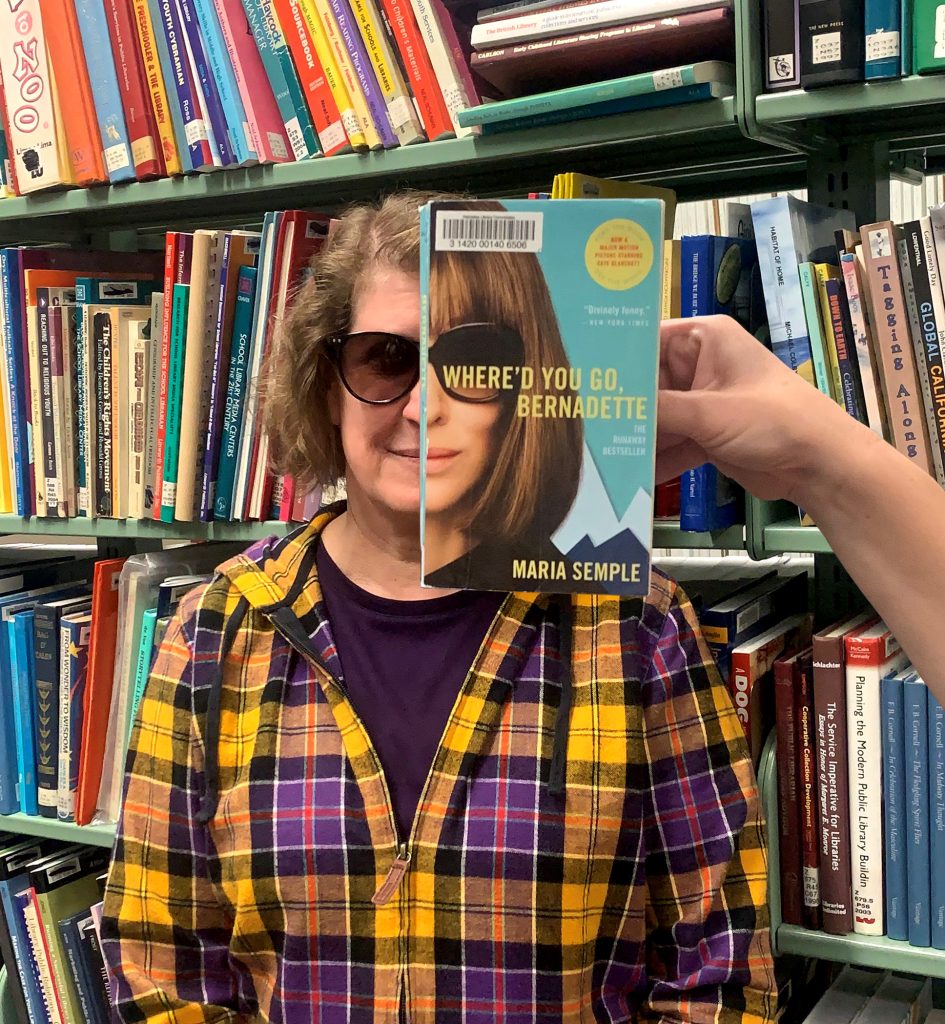
Lighten the mood with this week’s #BookFace, “Where’d You Go, Bernadette: A Novel” by Maria Semple (Back Bay Books, 2013), a hilarious novel about a mother and daughter. It’s available for checkout as an ebook and Audiobook from Nebraska Overdrive Libraries, as part of the curated collection “Have a Laugh: Humorous Reads.” This title is also available as a Book Club Kit; we have thirteen copies available along with discussion questions.
“In her second novel…Semple pieces together a modern-day comic caper full of heart and ingenuity….a compelling composite of a woman’s life-and the way she’s viewed by the many people who share it. As expected from a writer who has written episodes of Arrested Development, the nuances of mundane interactions are brilliantly captured, and the overarching mystery deepens with each page, until the thoroughly satisfying dénouement.”
—Publisher’s Weekly (Starred Review)
Book Club Kits Rules for Use
- These kits can be checked out by the librarians of Nebraska libraries and media centers.
- Circulation times are flexible and will be based upon availability. There is no standard check-out time for book club kits.
- Please search the collection to select items you wish to borrow and use the REQUEST THIS KIT icon to borrow items.
- Contact the Information Desk at the Library Commission if you have any questions: by phone: 800/307-2665, or by email: Information Services Team
Find this title and many more through Nebraska OverDrive! Libraries participating in the Nebraska OverDrive Libraries Group currently have access to a shared and growing collection of digital downloadable audiobooks and eBooks. 194 libraries across the state share the Nebraska OverDrive collection of 26,174 audiobooks, 36,611 ebooks, and 5,210 magazines. As an added bonus it includes 130 podcasts that are always available with simultaneous use (SU), as well as SU ebooks and audiobook titles that publishers have made available for a limited time. If you’re a part of it, let your users know about this great title, and if you’re not a member yet, find more information about participating in Nebraska Overdrive Libraries!
Love this #BookFace & reading? Check out our past #BookFaceFriday photos on the Nebraska Library Commission’s Facebook page!
Friday Reads: Will Trent Novels
I don’t know about you, but I am a sucker for a good book series. I blame my favorite childhood series, because once I find a character I like I just want their story to continue. Lately I’ve been deep into mystery and detective novels, including Karin Slaughter’s Will Trent series, Triptych, Fractured, Undone, and Broken. I’m currently on the fourth book in this twelve book series, and have enjoyed the world and characters that Karin Slaughter has created with character crossovers from her other book series including The Grant County Series.
Set mainly in Atlanta, Karin Slaughter’s Will Trent series begins with Triptych, where you meet Georgia Bureau of Investigation (GBI) Special Agent Will Trent and a slew of other characters that will continue throughout the series. Including his hard as nails GBI boss, Amanda Wagner, various childhood acquaintances, and other law enforcement officers. Orphaned as an infant, Will Trent spent his entire childhood as a ward of the state, growing up in group homes and foster care. And for his entire adult life, Trent has been concealing that he is barely able literate. Due to his unconventional childhood, he’s been living with undiagnosed dyslexia, finding creative ways to work around this problem, and keep it a secret. In spite of all this, or perhaps because of it, he’s an observant, thoughtful, and dedicated detective, solving crimes and seeing what others do not.
Now a series on the Hulu streaming service, Will Trent and his dog Betty are out there for everyone, even those non-readers, and it is a great TV show.
Slaughter, Karin. Triptych. Delacorte Press. 2006
Posted in Books & Reading, General
Tagged books, Crime, Fiction, Friday Reads, Karin Slaughter, mystery, Novel, Reading, series, Will Trent Series
Leave a comment
#BookFaceFriday “Red Stilts” by Ted Kooser
Relax and read a verse this #BookFaceFriday.

April is National Poetry Month, and we wanted to celebrate by highlighting Nebraskan poet Ted Kooser. Pulitzer Prize winner, 04-06 U.S. Poet Laureate, and winner of many awards including four Nebraska Book Awards and 2011’s One Book One Nebraska; Kooser’s poetry has touched the hearts of many. Each poem in this week’s #BookFace, “Red Stilts” (Copper Canyon Press, 2022), strives to reveal the complex beauties of the ordinary, of the world that’s right under our noses. It’s available for checkout as an ebook from Nebraska Overdrive Libraries, along with several other Ted Kooser titles.
If you’re looking for ways to celebrate National Poetry Month, take a look at the poetry genre from the drop-down menu on our Book Club Kit page. There are also a handful of Kooser’s titles available for request as well.
“Red Stilts” demonstrates that poets, like fine wines, continue to improve with age… Those familiar with Kooser’s work will recognize his skill at connecting the ordinary events of daily life to the sublime.”
—Lincoln Journal Star
Book Club Kits Rules for Use
- These kits can be checked out by the librarians of Nebraska libraries and media centers.
- Circulation times are flexible and will be based upon availability. There is no standard check-out time for book club kits.
- Please search the collection to select items you wish to borrow and use the REQUEST THIS KIT icon to borrow items.
- Contact the Information Desk at the Library Commission if you have any questions: by phone: 800/307-2665, or by email: Information Services Team
Find this title and many more through Nebraska OverDrive! Libraries participating in the Nebraska OverDrive Libraries Group currently have access to a shared and growing collection of digital downloadable audiobooks and eBooks. 194 libraries across the state share the Nebraska OverDrive collection of 26,174 audiobooks, 36,611 ebooks, and 5,210 magazines. As an added bonus it includes 130 podcasts that are always available with simultaneous use (SU), as well as SU ebooks and audiobook titles that publishers have made available for a limited time. If you’re a part of it, let your users know about this great title, and if you’re not a member yet, find more information about participating in Nebraska Overdrive Libraries!
Love this #BookFace & reading? Check out our past #BookFaceFriday photos on the Nebraska Library Commission’s Facebook page!
Book Club Spotlight- The Man Who Loved Books Too Much
Obviously this week, National Library Week, is the best week of the year! Celebrations include Right to Read Day, National Library Workers Day, National Library Outreach Day, and Take Action for Libraries Day. While we all know the importance of the library ecosystem, former San Francisco Library Laureate, Allison Hoover Bartlett, shares the story of what happens when greed and personal gain take over and infiltrate the book market. In her book, The Man Who Loved Books Too Much: The True Story of a Thief, a Detective, and a World of Literary Obsession, Bartlett follows the trail of notorious book thief John Charles Gilkey and peeks into the psyche of those who collect rare books, and what happens when that collecting becomes a compulsion.
Allison Bartlett entered into the world of book thieves by way of coincidence. A friend had come into possession of a stolen rare book after his brother’s passing, and Allison was drawn to its mysterious pages. As she felt this pull towards the illicit book, she began researching the history of book thievery, asking: “What makes someone cross the line from admirer to thief?”. It’s not long until two names come to her attention: Ken Sanders, a rare book dealer whose obsession with catching book thieves, leads Allison to the main focus of her story, John Charles Gilkey. For John, his (stolen) book collection is not about the contents of the books themselves, but merely the status it affords him. Growing up, he dreamed of being like the upper-crust gentlemen who honed grand libraries and garnered admiration. John takes to fraud and theft to achieve this dream, growing bolder and more self-assured as his collection grows. And his curation list? The Modern Library’s List of 100 Best Novels. Follow along with the strained and strange relationship between booksellers and the titular book thief. Where each believes the other is the true criminal.
“It wasn’t merely a love of books that compelled him, but also what owning them would say about him. It’s a normal ambition—that our choice of music or cars or shoes reflects well on us—taken to the extreme.”
Allison Hoover Bartlett
Part True Crime, part history of book collecting and fervor, The Man Who Loved Books Too Much is about trying to understand the psyche of these collectors and those who experience book-collecting mania, or Bibliomania. According to Bartlett, in rare book collections, the physical properties of the books, the memories associated with the title, or the historical importance of that edition are often more valuable than the actual contents within them. Book Club Groups will love the low-stakes True Crime aspect and exploring what in the mind can drive us to place such value on having personal library collections.
As Bartlett finds herself more entrenched in the rare book collection space, she notes that it largely consists of rich white men. While their hobbies are viewed as intellectual, there has been a trend of treating young female celebrities and models who carry around the latest literary fiction novel (“Literary It Girls”) as lesser and shallow attempts at intellectualism. But what is their real difference? Rare book collecting and John Gilkey’s obsession with the status symbol he associated with the books he stole can bring to light a much-needed discussion about the value we place on our favorite pastime, classism and maybe even a hidden misogynistic agenda.
Further Resources:
- More Stories of Book Theft:
- “Booktok and the Hotgirlification of Reading”:
If you’re interested in requesting The Man Who Loved Books Too Much for your book club, you can find the Request Form here. There are 5 copies available. (A librarian must request items)
Bartlett, Allison Hoover. The Man Who Loved Books Too Much. Riverhead Books. 2009
#BookFaceFriday “The Second Mrs. Astor” by Shana Abé
Come sail away with #BookFaceFriday!
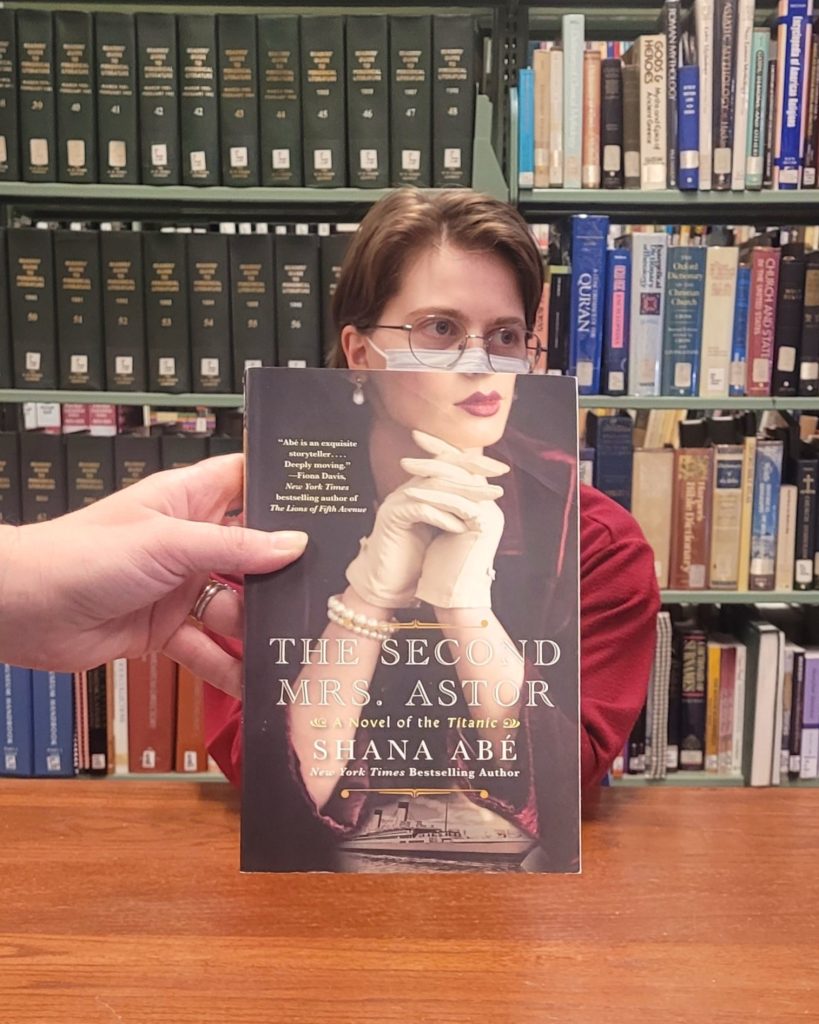
Grab your life jackets, this week’s #BookFace is about to hit rough waters!
“The Second Mrs. Astor: a Novel of the Titanic” by Shana Abé (Kensington Books, 2021) is the story of the scandalous marriage of one of America’s wealthiest businessmen and his decades-younger bride. After a lovely honeymoon abroad, they head for home on a brand-new ship… and you probably can guess how that chapter ends! This historical fiction title is available as an ebook and audiobook in Nebraska OverDrive Libraries, and is one of many titles that are always available; their publishers allow for for simultaneous use (SU), so you can skip the wait and find a great read now!“Abé is an exquisite storyteller. Rich in detail and deeply moving.”
—Fiona Davis, New York Times bestselling author of The Magnolia Palace
This week’s model is our brand-new Talking Book & Braille Service (TBBS) Reader Services Advisor, Jo Mezger. Jo comes to us by way of Lincoln City Libraries, and their favorite genre to read is magical realism (but they could while away hours with the hip-hop books at LCL’s Polley Music Library as well!) Welcome aboard Jo!
Find this title and many more through Nebraska OverDrive! Libraries participating in the Nebraska OverDrive Libraries Group currently have access to a shared and growing collection of digital downloadable audiobooks and eBooks. 194 libraries across the state share the Nebraska OverDrive collection of 26,174 audiobooks, 36,611 ebooks, and 5,210 magazines. As an added bonus it includes 130 podcasts that are always available with simultaneous use (SU), as well as SU ebooks and audiobook titles that publishers have made available for a limited time. If you’re a part of it, let your users know about this great title, and if you’re not a member yet, find more information about participating in Nebraska Overdrive Libraries!
Love this #BookFace & reading? Check out our past #BookFaceFriday photos on the Nebraska Library Commission’s Facebook page!
#BookFaceFriday “It’s a Question of Space” by Clayton C. Anderson
Ground Control to Major #BookFace!
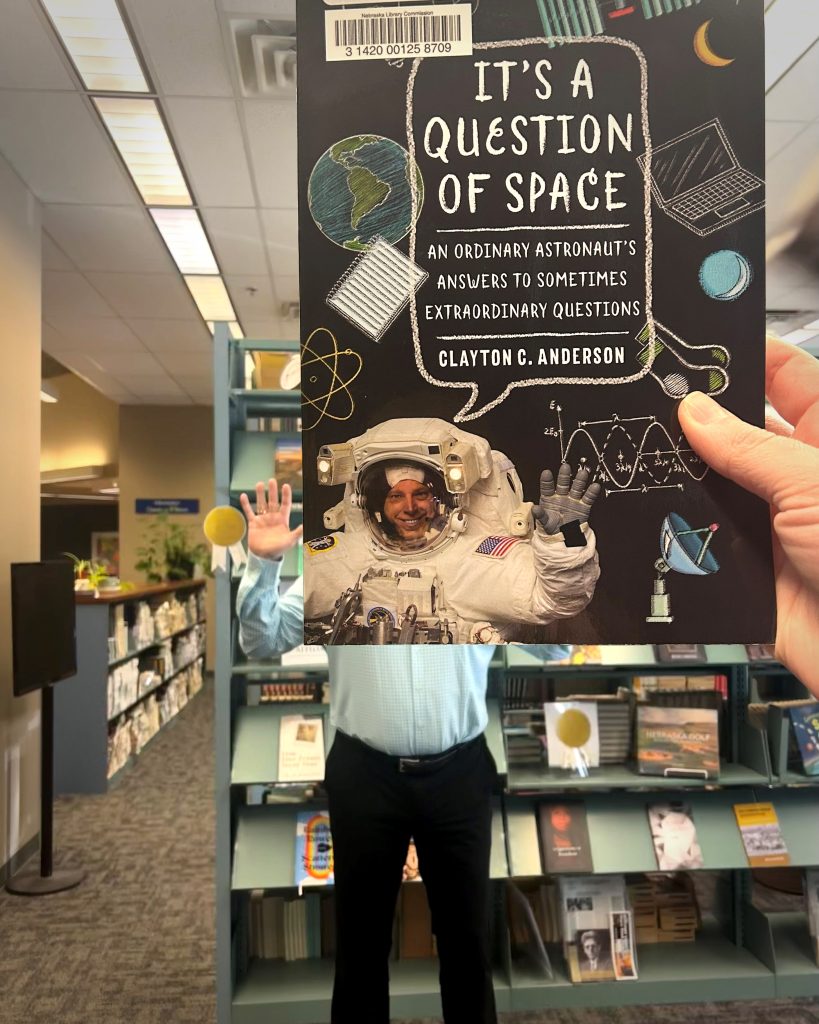
This #BookFace Friday is out of this world! We love featuring Nebraska authors and this week it’s a real life astronaut to boot. Astronaut Clayton Anderson is the author of five books including “It’s a Question of Space: An Ordinary Astronaut’s Answers to Sometimes Extraordinary Questions” (University of Nebraska Press, 2018.) This title as well as his memoir “The Ordinary Spaceman” are available as eBooks in Nebraska OverDrive Libraries. This week’s model is Clayton Anderson himself! He was in the office this week dropping off posters for Nebraska Libraries! We’ll be getting these posters to your Nebraska Regional Library System Directors at the spring Systems Meeting so librarians can let their local Systems know if they are interested in a free poster.
“Clay Anderson dispels myths and simplifies complex subjects for the reader and with examples from his personal experiences provides insight into the daily life of an astronaut. As a teacher trying to fuel the curiosity of and relate relevant topics to students, I would keep a copy of this book on my desk.”
—Dottie Metcalf-Lindenburger, earth scientist, educator, and retired astronaut
Find this title and many more through Nebraska OverDrive! Libraries participating in the Nebraska OverDrive Libraries Group currently have access to a shared and growing collection of digital downloadable audiobooks and eBooks. 194 libraries across the state share the Nebraska OverDrive collection of 26,174 audiobooks, 36,611 ebooks, and 5,210 magazines. As an added bonus it includes 130 podcasts that are always available with simultaneous use (SU), as well as SU ebooks and audiobook titles that publishers have made available for a limited time. If you’re a part of it, let your users know about this great title, and if you’re not a member yet, find more information about participating in Nebraska Overdrive Libraries!
Love this #BookFace & reading? Check out our past #BookFaceFriday photos on the Nebraska Library Commission’s Facebook page!
Friday Reads: Dark, Salt, Clear by Lamorna Ash
My favorite book discoveries are often found nestled amongst travel guides. While guidebooks often shrink small towns into succinct paragraphs, and weigh their significance based on subjective criteria suited for outsiders, I love a book that digs deeper into a place. Dark, Salt, Clear: The Life of a Fishing Town is one of these finds.
Lamorna Ash is a twenty-something Londoner, who ventures to the Cornish coastline to learn about fishing. Although she is an outsider, she has roots in Cornwall. Her mother was raised there and named her daughter for a Cornish village. Lamorna settles in Newlyn, a town centered on the fishing industry, steeped in tradition, but also rapidly changing. The locals quickly welcome her into their lives and workplaces, allowing her access to the various enterprises, including participating in the catch, processing fish, and observing the wholesale auction in an ever changing global market.
Dark, Salt, Clear is not just a story about fishing. It’s about the people, the place, and the complex beauty of it all. Ash peppers her story with poetry and prose from others who experienced the sea and its coastlines. The book’s title comes from the poem “At the Fishhouses” (1947) by Elizabeth Bishop:
“It is like what we imagine knowledge to be:
dark, salt, clear, moving, utterly free,
drawn from the cold hard mouth
of the world, derived from the rocky breasts
forever, flowing and drawn, and since
our knowledge is historical, flowing, and flown.”
Ash is also adept at interweaving her own poetic observations about life and the natural world, and often reflects on the things she learns from the people she meets including captains, deckhands, birdwatchers, fishmongers, processors, barkeeps, and geologists.
“A geologist’s task is to see beyond the ways in which time tries to smooth out difference, examining layers in order to isolate each sift to our world, to feel every fault line. We discuss how hard this is to do this with people, to imagine our lives not as one continuous line, but comprised of hundreds of versions, stacked up behind us, and hundreds more ahead of us too, like those pairs of facing mirrors that make your reflection curl up infinitely on either side of you.”
The book not only explores what it means to work in the fishing industry, but also what it means to live in a place that is so connected to the sea. As a person who grew up in a small coastal town in the Pacific Northwest, I was intrigued to learn about another coastal town across the globe. Books, like travel, can broaden our horizons, but also connect us. People in Cornwall look for the illusive “Green Flash” just like the residents of my hometown. The fishing industry everywhere is effected by globalization and climate change. Small seaside towns struggle with similar issues like tensions between tourism and industry. Fishing families across the globe are impacted by metal health issues, tragedy, and grief.
If you are curious about the natural world and the human experience in a small town across the Atlantic, check out Dark, Salt, Clear. While I picked up a physical copy of this book from my local library, you can also read it as an ebook through the Nebraska OverDrive Libraries.
Ash, Lamorna. Dark, Salt, Clear: the Life of a Fishing Town. Bloomsbury, 2020.
Book Club Spotlight – The Daughter of Time
With the British Royal Family gossip mill recently abuzz, and as the sun sets on Women’s History Month, now is the perfect opportunity to visit Josephine Tey’s 1951 novel The Daughter of Time, and take a step back to the 15th century to investigate the murderous reputation of Richard III. Holding the top spot in the British Crime Writers’ Association’s list of Top 100 Crime Novels of All Time, The Daughter of Time is quite the influential novel, leading in part to the discovery of Richard III’s burial site in 2012. Like Nebraska’s own Mignon G. Eberhart, Tey wrote during what is called the “Golden Age of Crime Fiction”, and her novels continue to surprise and delight readers.
Hospitalized from his latest case, Inspector Alan Grant is at a loss for entertainment. Having counted the ceiling tiles and studied the comings and goings of his nurses, he is growing restless. It’s not until a friend suggests he attempt to solve a cold case from his hospital bed does inspiration strike. Examining a portrait of the late King Richard III, Grant (a fan of physiognomy) doesn’t see the ruthless uncle who would kill his two young nephews. He sees a gentle man, lost to time. With the help of a young American researcher, Grant races across histories written by second hands with ulterior motives. And as the pair work to challenge myths and legends to clear Richard’s name, they can’t help but wonder, what could be gained by besmirching an usurped King?
“The truth of anything at all doesn’t lie in someone’s account of it. It lies in all the small facts of the time. An advertisement in a paper, the sale of a house, the price of a ring.”
Josephine Tey
Chock full of wit and political intrigue, The Daughter of Time is a history lesson like no other. Our copies at the Commission include a 2013 introduction by the late author Robert Barnard whose overview of Josephine Tey (real name Elizabeth Mackintosh) includes her writing style, spot in history, and acknowledgments of prejudices characteristic of her time which are unfortunately present in the text. Book Club groups will enjoy exploring the very real mystery of Richard III and the unknown fate of the two Princes in the Tower against the safe and removed backdrop of Grant’s hospital bed. And the delightful repartee between characters cannot be understated, from puns to inquiring over the ownership of who gets to die in the Thames- Tey is truly a master of the genre.
If you’re interested in requesting The Daughter of Time for your book club, you can find the Request Form here. There are 7 copies available. (A librarian must request items)
Tey, Josephine. The Daughter of Time. Simon and Schuster. 1951
Posted in Books & Reading
Tagged book club spotlight, books, Reading, Women's History Month
Leave a comment
#BookFaceFriday – “Reader’s Digest: Special Pets Issue”
This #Bookface is ready to sit and stay.

It’s hard to teach an old dog new tricks, and it’s easy to forget you have access to magazines on Nebraska OverDrive Libraries! Take a look at “Reader’s Digest” just one of 3,596 English titles now available as an eBook from Nebraska OverDrive Libraries! Three years of issues are available of many titles, as well as some single titles (generally special edition issues of certain magazines or items like adult coloring books). Magazines do not count against a reader’s checkout limit of 6, and magazine issues may be checked out for 7, 14, or 21 days, depending on your library’s policy. Along with all the English-language titles, you have access to Spanish-language titles, and many other languages including French, German, Chinese, Japanese, Russian, Afrikaans, and Italian.
“In this era of information overload, Reader’s Digest offers something unique: the very best advice, information and inspiration from multiple sources, condensed into an easy-to-read digest. In each issue you’ll get trusted, time-saving insights about Health, Personal Finance, Work, Family, and National issues, PLUS exclusive book excerpts, news-making interviews, and humor.”
Reader’s Digest Blurb
Libraries participating in the Nebraska OverDrive Libraries Group currently have access to a shared and growing collection of digital downloadable audiobooks and eBooks. 194 libraries across the state share the Nebraska OverDrive collection of 26,174 audiobooks, 36,611 ebooks, and 5,210 magazines. As an added bonus it includes 130 podcasts that are always available with simultaneous use (SU), as well as SU ebooks and audiobook titles that publishers have made available for a limited time. If you’re a part of it, let your users know about this great title, and if you’re not a member yet, find more information about participating in Nebraska Overdrive Libraries!
Love this #BookFace & reading? We suggest checking out all the titles available in our Book Club collection, permanent collection, and Nebraska OverDrive Libraries. Check out our past #BookFaceFriday photos on the Nebraska Library Commission’s Facebook page!
Posted in Books & Reading, General
Tagged bookface, bookfacefriday, books, Ebook, Magazine, Nebraska OverDrive Libraries, Reader's Digest, Reading
Leave a comment







